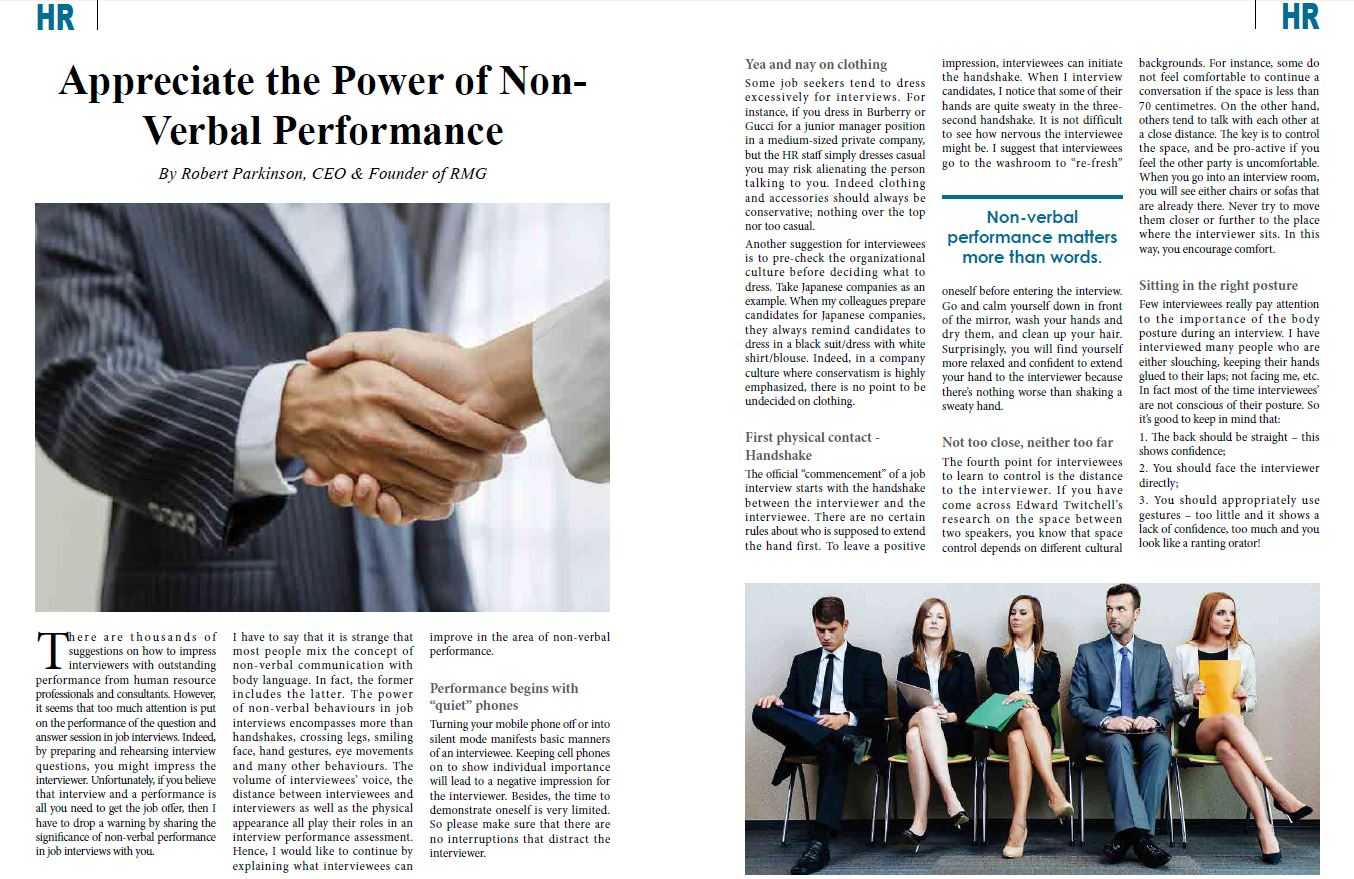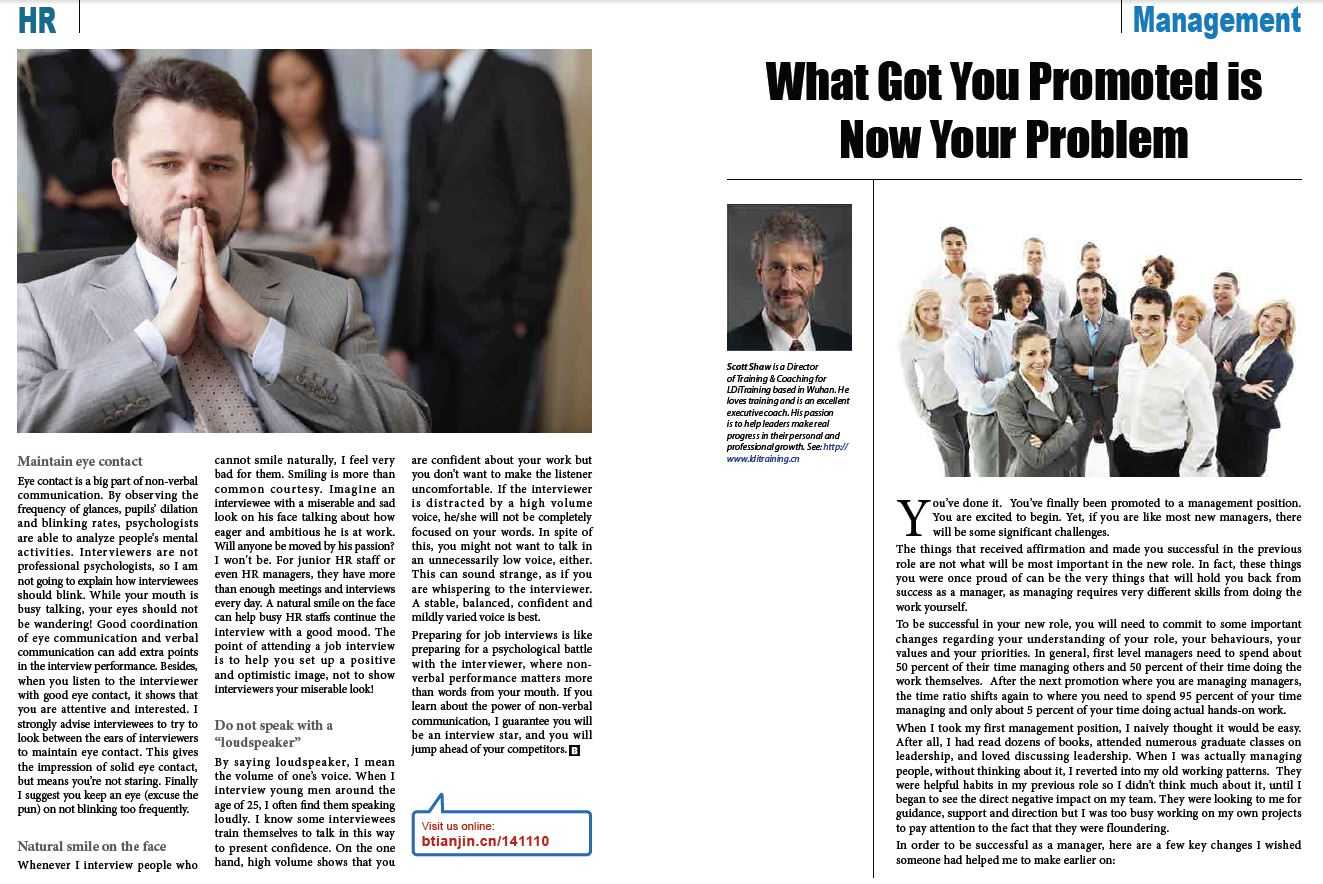There are thousands of suggestions on how to impress interviewers with outstanding performance from human resource professionals and consultants. However, it seems that too much attention is put on the performance of the question and answer session in job interviews. Indeed, by preparing and rehearsing interview questions, you might impress the interviewer. Unfortunately, if you believe that interview and a performance is all you need to get the job offer, then I have to drop a warning by sharing the significance of non-verbal performance in job interviews with you.
I have to say that it is strange that most people mix the concept of non-verbal communication with body language. In fact, the former includes the latter. The power of non-verbal behaviours in job interviews encompasses more than handshakes, crossing legs, smiling face, hand gestures, eye movements and many other behaviours. The volume of interviewees’ voice, the distance between interviewees and interviewers as well as the physical appearance all play their roles in an interview performance assessment. Hence, I would like to continue by explaining what interviewees can improve in the area of non-verbal performance.
Performance begins with “quiet” phones
Turning your mobile phone off or into silent mode manifests basic manners of an interviewee. Keeping cell phones on to show individual importance will lead to a negative impression for the interviewer. Besides, the time to demonstrate oneself is very limited. So please make sure that there are no interruptions that distract the interviewer.
Yea and nay on clothing
Some job seekers tend to dress excessively for interviews. For instance, if you dress in Burberry or Gucci for a junior manager position in a medium-sized private company, but the HR staff simply dresses casual you may risk alienating the person talking to you. Indeed clothing and accessories should always be conservative; nothing over the top nor too casual.
Another suggestion for interviewees is to pre-check the organizational culture before deciding what to dress. Take Japanese companies as an example. When my colleagues prepare candidates for Japanese companies, they always remind candidates to dress in a black suit/dress with white shirt/blouse. Indeed, in a company culture where conservatism is highly emphasized, there is no point to be undecided on clothing.
First physical contact – Handshake
The official “commencement” of a job interview starts with the handshake between the interviewer and the interviewee. There are no certain rules about who is supposed to extend the hand first. To leave a positive impression, interviewees can initiate the handshake. When I interview candidates, I notice that some of their hands are quite sweaty in the three second handshake. It is not difficult to see how nervous the interviewee might be. I suggest that interviewees go to the washroom to “re-fresh” oneself before entering the interview. Go and calm yourself down in front of the mirror, wash your hands and dry them, and clean up your hair. Surprisingly, you will find yourself more relaxed and confident to extend your hand to the interviewer because there’s nothing worse than shaking a sweaty hand.
Not too close, neither too far
The fourth point for interviewees to learn to control is the distance to the interviewer. If you have come across Edward Twitchell’s research on the space between two speakers, you know that space control depends on different cultural backgrounds. For instance, some do not feel comfortable to continue a conversation if the space is less than 70 centimetres. On the other hand, others tend to talk with each other at a close distance. The key is to control the space, and be pro-active if you feel the other party is uncomfortable. When you go into an interview room, you will see either chairs or sofas that are already there. Never try to move them closer or further to the place where the interviewer sits. In this way, you encourage comfort.
Sitting in the right posture
Few interviewees really pay attention to the importance of the body posture during an interview. I have interviewed many people who are either slouching, keeping their hands glued to their laps; not facing me, etc. In fact most of the time interviewees’are not conscious of their posture. So it’s good to keep in mind that:
- The back should be straight – this shows confidence;
- You should face the interviewer directly;
- You should appropriately use gestures – too little and it shows a lack of confidence, too much and you look like a ranting orator!
Maintain eye contact
Eye contact is a big part of non-verbal communication. By observing the frequency of glances, pupils’ dilation and blinking rates, psychologists are able to analyze people’s mental activities. Interviewers are not professional psychologists, so I am not going to explain how interviewees should blink. While your mouth is busy talking, your eyes should not be wandering! Good coordination of eye communication and verbal communication can add extra points in the interview performance. Besides, when you listen to the interviewer with good eye contact, it shows that you are attentive and interested. I strongly advise interviewees to try to look between the ears of interviewers to maintain eye contact. This gives the impression of solid eye contact, but means you’re not staring. Finally I suggest you keep an eye (excuse the pun) on not blinking too frequently.
Natural smile on the face
Whenever I interview people who cannot smile naturally, I feel very bad for them. Smiling is more than common courtesy. Imagine an interviewee with a miserable and sad look on his face talking about how eager and ambitious he is at work. Will anyone be moved by his passion? I won’t be. For junior HR staff or even HR managers, they have more than enough meetings and interviews every day. A natural smile on the face can help busy HR staffs continue the interview with a good mood. The point of attending a job interview is to help you set up a positive and optimistic image, not to show interviewers your miserable look!
Do not speak with a“loudspeaker”
By saying loudspeaker, I mean the volume of one’s voice. When I interview young men around the age of 25, I often find them speaking loudly. I know some interviewees train themselves to talk in this way to present confidence. On the one hand, high volume shows that you are confident about your work but you don’t want to make the listener uncomfortable. If the interviewer is distracted by a high volume voice, he/she will not be completely focused on your words. In spite of this, you might not want to talk in an unnecessarily low voice, either. This can sound strange, as if you are whispering to the interviewer.A stable, balanced, confident and mildly varied voice is best.
Preparing for job interviews is like preparing for a psychological battle with the interviewer, where nonverbal performance matters more than words from your mouth. If you learn about the power of non-verbal communication, I guarantee you will be an interview star, and you will jump ahead of your competitors.
(Pic via Business Tianjin)

